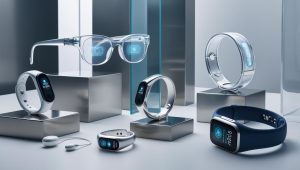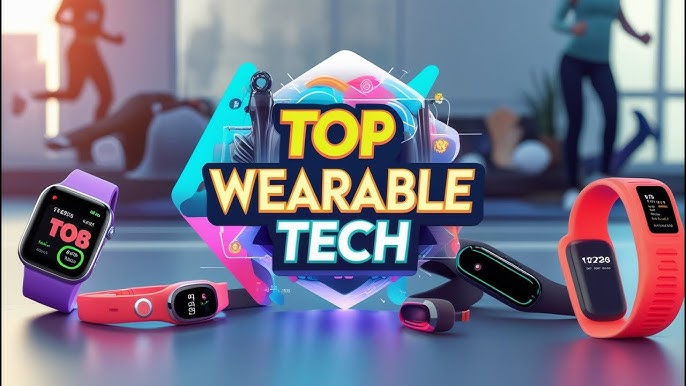Introduction Wearable technology has moved far beyond simple step counters. In 2025, wearable tech trends focus on deeper health insights, seamless integration, and sustainable design. Consumers expect devices that blend with everyday life—smart clothing that tracks posture, rings that monitor sleep, and glasses that overlay real-world info. Companies are racing to add AI, advanced sensors,
Introduction
Wearable technology has moved far beyond simple step counters. In 2025, wearable tech trends focus on deeper health insights, seamless integration, and sustainable design. Consumers expect devices that blend with everyday life—smart clothing that tracks posture, rings that monitor sleep, and glasses that overlay real-world info. Companies are racing to add AI, advanced sensors, and eco-friendly materials to wearables. Whether you’re a fitness enthusiast, a busy professional, or someone who wants better health data, the latest 2025 wearable tech offers something for you. Let’s explore the top trends shaping the future of wearable technology this year.
Latest Trends in Wearable Technology: What’s New in 2025?

Image by: Yandex.com
1. Smart Textiles and E-Textiles
In 2025, smart textiles lead the way in wearable technology. Fabric is no longer passive; it can sense motion, temperature, and even bio-signals. Workout shirts now include fine electrodes to measure muscle activity, helping athletes optimize performance. Jackets with built-in heating elements adjust warmth automatically based on weather. Some fabrics change color or pattern through small embedded LEDs. E-textiles promise comfort and durability since sensors are woven into fibers rather than glued on. As a result, smart clothing feels like regular wear but delivers powerful data—pushing the boundary between fashion and function.
2. Advanced Health and Biometric Sensors
Health monitoring is a top use case for 2025 wearable tech trends. Beyond heart rate and steps, new wearables track blood sugar, hydration levels, and even blood pressure without cuffs. Optical sensors use infrared light to measure blood flow changes, while sweat sensors detect electrolyte balance in real time. Some devices analyze skin temperature and heart rate variability to predict illness before symptoms appear. Continuous glucose monitors that once required small implants are now noninvasive patches on the skin. These advances turn wearables into proactive health tools, helping users manage chronic conditions and maintain well-being.
3. AR and Mixed Reality Glasses
Augmented reality (AR) glasses are no longer prototypes—they’re consumer-ready in 2025. Lightweight frames project navigation cues, translation subtitles, and smartphone notifications into your field of view. For remote workers, AR glasses display a floating screen for video calls and presentations. Gamers use them for immersive experiences that blend digital characters with real environments. Mixed reality apps let you rearrange virtual furniture in your living room or get step-by-step cooking guides in your kitchen. With faster processors and improved battery life, these glasses bring the digital world into focus without bulky headsets.
4. Smart Rings and Minimalist Wearables
Not everyone wants a wristband or a watch. Smart rings have emerged as a top wearable technology trend in 2025. These sleek bands track sleep stages, resting heart rate, and activity with medical-grade accuracy. A simple tap can unlock doors, make payments, or control smart home devices. Many rings last up to a week on a single charge and are waterproof, so you can wear them around the clock. For users who prefer discreet gadgets, smart rings offer core fitness and payment features in a minimalist package—proving small devices can deliver big benefits.
5. AI-Powered Personal Assistants
Artificial intelligence is powering the next generation of wearables. Instead of raw data, devices now offer tailored insights and suggestions. A fitness tracker might notice you’re more stressed on Mondays and suggest breathing exercises. A smart ring could alert you to signs of poor sleep quality weeks in advance, offering personalized tips. Voice assistants in earbuds or glasses respond instantly, controlling your calendar or playing music without your phone. This shift from tracking to coaching makes wearable tech more valuable, as AI learns from your habits to support healthier, more productive routines.
6. Implantable and Ingestible Sensors
For ultimate accuracy, some 2025 wearables go under the skin. Implantable sensors the size of a grain of rice monitor glucose, hormones, or medication levels continuously. An implanted chip can store encrypted health data and send it via Bluetooth to your phone. Ingestible sensors, contained in a pill, travel through your digestive tract and relay data on gut health and nutrient absorption. While still niche and subject to regulation, these technologies promise unmatched precision. They turn the human body into its own laboratory, offering doctors and patients real-time data for better treatment decisions.
7. Sustainable and Biodegradable Devices
Eco-conscious consumers demand greener wearable technology. In 2025, many brands use sustainable materials like recycled plastics, plant-based polymers, or biodegradable sensors. Modular designs allow easy part replacement and repair, extending device life. Packaging is minimal and made from recycled paper or compostable materials. Some wearables integrate solar-harvesting textiles to cut charging needs. By reducing e-waste and sourcing responsibly, companies meet consumer expectations for sustainability while still delivering advanced features. As a result, eco-friendly wearables help protect the planet without sacrificing performance.
8. Enhanced Connectivity and 5G Integration
The rollout of 5G networks accelerates wearable tech trends by offering faster data speeds and lower latency. Wearables can stream high-quality audio for headsets and glasses without dropped connections. Real-time health data uploads enable telemedicine consultations anywhere. Multiple devices sync seamlessly—your smartwatch, smart glasses, and earbuds share context to provide unified notifications. Edge computing pushes AI processing from the cloud to the device, improving privacy and reducing power draw. With 5G, wearables become more reliable and responsive, unlocking new applications in fitness, healthcare, and enterprise.
9. Hybrid Devices for Work and Play
In 2025, wearables blur lines between leisure and productivity. Hybrid devices pair workout tracking with remote work tools. Smartwatches now include features like calendar sync, quick email replies, and voice dictation. Fitness clothing integrates posture sensors that vibrate gently when you slouch at your desk. AR glasses switch between gaming mode and office mode, overlaying spreadsheets or workout stats with a single gesture. This fusion of fitness, work, and entertainment makes wearables essential companions for modern life—adapting dynamically to your changing daily needs.
Conclusion
The latest wearable technology trends in 2025 reveal a future where devices are smaller, smarter, and more sustainable than ever. Smart textiles and advanced health sensors deliver deeper insights, while AR glasses and smart rings offer seamless integration into daily life. AI-powered assistants turn raw data into actionable guidance, and implantable sensors promise precision care. Sustainability drives design choices, and 5G connectivity ensures real-time performance. As wearables evolve into hybrid work-play companions, they empower us to live healthier, greener, and more connected lives. Embracing these trends will keep you at the cutting edge of wearable tech in 2025 and beyond.
















